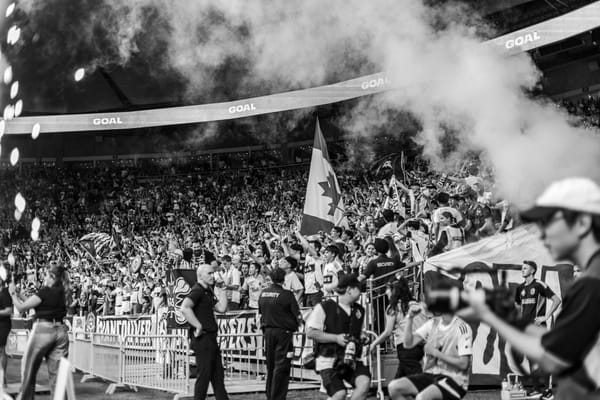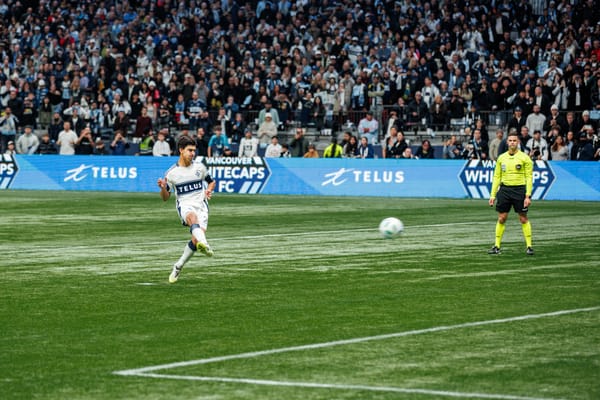Mailbag: January 2025
More answers to more questions!
It’s the end of January, so it’s time for another mailbag! Well, that’s the intro settled, so let’s get to the questions. Starting with the only question from the butterfly website:
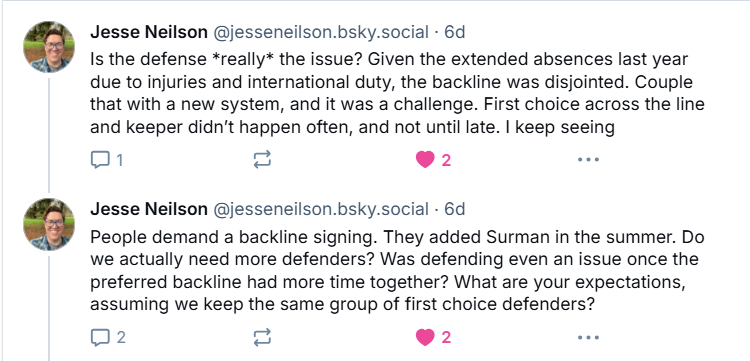
This might be a cop-out, but this is the essence of what I’ll be tackling in an upcoming paywalled article. However, because I’m a nice guy, I’ll spoil part of my answer: I think Portland’s defensive struggles are very overexaggerated. Stay tuned for the “why.”
Cascadia FC's Substack is a reader-supported publication. To receive new posts and support my work, consider becoming a free or paid subscriber.
Now that the lone Bluesky question (username is @jeremypeterman.bsky.social if you haven’t followed me on there yet) has been tackled, let’s answer the questions from Joseph Goebbels’ Family Fun Forum.

There are serious pros and cons if MLS decided to shift to a August-May calendar. But it’s important to recognize that MLS is competing for eyeballs on two different fronts: the domestic audience and foreign viewers.
Let’s start with American audiences. Specifically, what is MLS competing with? The season starts after the Super Bowl, but the opening stages occur during the end of the NBA and NHL regular seasons (when both of those sports actually matter). Basketball and hockey playoffs dominate the landscape during late spring-early summer. But summer is when MLS only has one competitor: baseball. I love baseball, and I won’t listen to anyone who complains about it. However, NBA free agency and the beginning of NFL training camp seems to occupy airwaves for the major sports networks during this time. More on that later. College football and the NFL dominate the fall during the stretch run of the MLS season and into the playoffs. NBA and NHL have started back up again in the meantime. By the end of the season, MLS has painted itself into a corner where it isn’t the dominant sport at any time of the year. Only the summer comes close, but it’s a point in the schedule where very few high-stakes games are being played. In addition, the Leagues Cup break is a big pause in momentum. Americans who are fans of European clubs do not count in this analysis because there aren’t any time window conflicts with MLS games. Bottomline: with the current schedule, MLS is already operating at a disadvantage aside from the fans who are already invested in the league.
TANGENT: The Apple Deal
Earlier, I mentioned how the major sports networks tend to ignore MLS. Only Apple and FOX have the rights to broadcast MLS games. FOX doesn’t care about it, and Apple does a very poor job of marketing their product to a wider audience. Because the other networks don’t have any financial incentive to talk about MLS (sometimes they don’t even have the financial incentive to properly cover the sports they PAY to broadcast) there isn’t any coverage available on linear networks. Social media does a pretty good job of showing highlights, but full games are only available on Apple. Even though there are a fair amount of free games throughout the season, I fear that the Apple deal has made the league more inaccessible than it previously was. However, Apple is actually investing money and treating the games with the respect that they deserve. Next step: pour money into advertising and begin to rework the programming schedule.
Back to the Question at Hand
That might cover the American portion, but MLS is intent on finding relevance in the wider world of soccer. Time zones make it difficult for European fans to watch live games, but the difference isn’t as drastic for Mexico/South America. Right now, the American schedule works in favor of gaining European audiences. International tournaments complicate matters, but sicko soccer fans are always looking for some version of the sport to watch.
Domestic viewers should be the primary focus. If the league switched to a August-May schedule, the playoff matches would take place in the spring and would only be competing against NBA and NHL playoffs. The 2024 MLS Cup was scheduled to kick off at the same time as the SEC Championship Game. You’re shooting yourself in the foot with that kind of scheduling. But that’s just what MLS is competing with domestically. Soccer works on a global scale.
This includes the various international breaks that occur during the fall. Those interruptions (2 weeks in September, 2 weeks in October, 2 weeks in November) cause playoff teams to drastically lose momentum at the most important part of the calendar. A switch to the European schedule would eliminate these obstacles and allow the momentum from the end of the regular season to carry into the playoffs. Momentum is very important. Need any evidence? College football has the answer.
TANGENT NUMBER TWO: The Greatest American Sport
The Oregon Ducks won the Big Ten championship on December 7th, which guaranteed them the #1 seed in the expanded College Football Playoff thanks to an undefeated regular season. During their 13-0 campaign, the longest stretch between games for the Ducks was 2 weeks. That’s a normal practice during football season. One week without a game to recharge and institute new schemes on the practice field. However, after gaining the biggest possible advantage with the top seed, they waited TWENTY-FIVE days to play their next game. Ohio State, their opponent, hosted Tennessee 11 days before gameday in Pasadena. I would call the Buckeyes’ first round victory against Tennessee a “tune-up.” Even though Ohio State had to win another game in order to advance, they had an advantage. The Ducks showed up at the Rose Bowl and did not look sharp at all, which allowed the Buckeyes to jump out to a 34-0 lead before halftime. Rust is real. Oregon’s massive “advantage” turned into a double-edged sword.
Back to the Topic at Hand, Part Two
Lining up the European soccer schedule with MLS would be a net positive in terms of international breaks, playoffs, and momentum. This includes the summer breaks for international tournaments. MLS teams want their players to be available for every match. Forcing teams to play during these tournaments (often shorthanded, like last year’s Copa America) in a league with strict roster rules is not fair for competitive balance. But the biggest argument in favor of shifting the calendar is the biggest thing holding MLS back in the global soccer landscape: the transfer market.
In 2025, MLS will have two transfer windows. The Primary Window is open from January 31st-April 23rd. Calling it the “winter window” is pretty dumb because it extends so deep into spring. The “summer window” is only open for a month: July 24th-August 21st. Like Europe, MLS has a longer window at the beginning of the season. The mid-season window is shorter. However, because the European market dictates the world market, MLS teams are very limited during the most important parts of the squad-building season. American teams have the money to compete on the global scale. I’m going to ignore the roster rules for a moment, because they absolutely need to be changed to encourage more spending. But raising the salary cap and making a few other tweaks to the rules (such as eliminating transfer fees from cap hits) aren’t enough to shift the market in MLS’ favor. An August-May schedule while implementing the global transfer windows (yes, some leagues have different start dates but you get the point) can exponentially alter the growth trajectory.
Now, there are cons to the August-May schedule. Competing with football during the first half of the season is just a fact of life. However, the biggest obstacle has to be the climate. MLS is populated with cold-weather cities and during the winter months being outdoors can be hazardous for athletes and spectators. This is the same issue that MLS has to deal with in the summer but with the temperatures reversed. However, because the international breaks will actually be breaks, MLS can institute a winter break during the coldest months of the calendar. Several European leagues have winter breaks. Since the break isn’t at a high-leverage point in the schedule, it won’t have the same effect as the current breaks during international windows. The climate is the only major obstacle that the league will have to tackle, but there is a workable solution.
In conclusion, MLS should seriously consider switching to a August-May schedule. Natural obstacles like the climate are one thing, but MLS has put in several unenforced obstacles like Leagues Cup. Open Cup could be worked around, while CONCACAF Champions’ Cup would occur towards the end of the season with teams in full sharpness instead of preseason form. I think it would be a good move for the league as a whole while increasing domestic popularity at the same time.


I don’t need to answer this question because it has already been answered for me! On Thursday night, Tom Bogert of GIVEMESPORT reported that the Timbers have agreed to a deal for Colombian left-back Jimer Fory from Independiente Medellin. Time for a breakdown of the newest Timber.
Jimer Fory is 6’2” and 22 years old. In the span of one year, he won the Colombian league twice (like Liga MX, Colombia has two seasons over the course of one year). In 2024, he earned 3 caps with Colombia’s U23 team, which makes him a teammate of Juan Mosquera. His primary position is left back, but he can also play as a center back or anywhere on the left side of the pitch.
Fory’s statistical profile tells the story of a two-way fullback. His chance creation and crossing numbers are very high. The real gold mine comes in the defensive stats. He wins a lot of duels and doesn’t get dribbled past that often. There is one stat that jumps off the page: aerial duels. Per FotMob, Fory wins 2.88 aerial duels per 90. That ranks in the 98th percentile of all fullbacks. His aerial duel success rate of 75% is in the 94th percentile. Those numbers are outstanding, especially because he will immediately add more height and aerial ability to the backline. He has the profile of a player who will need some time to adjust but could blossom into a future key starter.
It’s now time to talk about the player that Fory will be competing with: Claudio Bravo. Since the Argentine arrived in 2021, there has been very little competition at left back. Ismaila Jome, Justin Rasmussen, Eric Miller, and Kamal Miller have been the backups during Bravo’s tenure. Only the DPs (and not even all of them, hello Yimmi and Niezgoda) haven’t had as much competition since 2021. Bravo’s contract is one of the best on the roster. On his day, the Argentine is one of the best left backs in the league. But inconsistency and injuries have led the Timbers to use makeshift solutions at a very important spot on the pitch. Adding that depth isn’t just in the team’s best interest; it’s in Bravo’s as well.
Complacency has been the biggest issue with Bravo over the past two seasons. In 2021 and 2022 he was one of the best players on the roster and, even with his faults, showed up every week. However, the biggest losses in the past two years have been compounded by poor Bravo games. Let’s take a look at the 5-0 loss in Houston; Giovanni Savarese’s final game in charge. Bravo gave away a penalty 5 minutes into the game. The Timbers didn’t recover, conceded three more goals in the first half, and Bravo was yanked at halftime. During last year’s catastrophe in the playoffs, multiple Bravo mistakes allowed the Whitecaps to build a 3-0 halftime lead. Bravo was yanked at halftime. It’s clear that Bravo has a lot of ability. But he needs a bit of competition to bring out the best in his game. That’s true for every player.
Acquiring a player with a different profile to their first-choice fullback is a wonderful bit of business. Fory’s aerial presence will be a huge asset to a team that struggles with back-post and set piece defending. Although the deal isn’t finalized yet, Fory should join the team for preseason in Coachella. He becomes the fourth acquisition that properly fills a team need. Bravo.

This is a question that has been percolating in the minds of many Timbers fans for the past couple of seasons. However, Diego Chara has been able to maintain such a high standard of play for so long that taking him out of the starting lineup would’ve been inconceivable two years ago. But the club captain is entering his age-38 season, and the recent acquisition of Joao Ortiz (who is TEN YEARS YOUNGER) is a very good succession plan. However, a reduction in Chara’s minutes was implemented last season. Let’s look at the numbers.
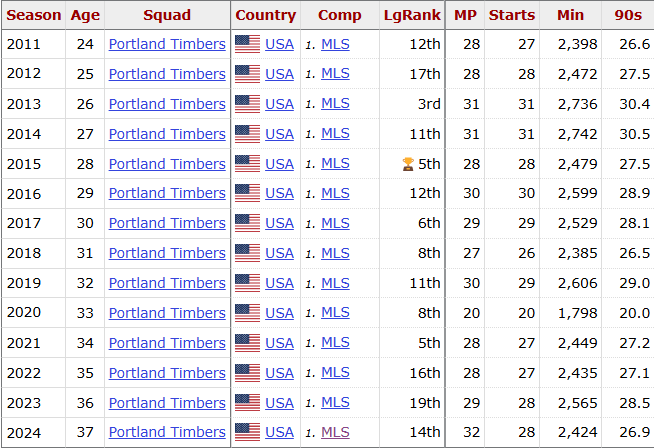
For the first time in his Timbers career, Chara made four substitute appearances in a single season during league play. The captain was fully healthy for the entirety of 2024. Phil Neville decided to pick optimal times to rest Chara (during 3-match weeks or short road turnarounds). This is a clever bit of management, but there was still a drop in quality when the captain was off the pitch. Once Ortiz adjusts, I think he will claim the starting role alongside David Ayala in Portland’s midfield. Does this mean that Chara won’t play? Of course not. Being able to bring Diego Chara off the bench to close out games is a luxury. The Timbers have been in this situation before, and they handled it pretty well.
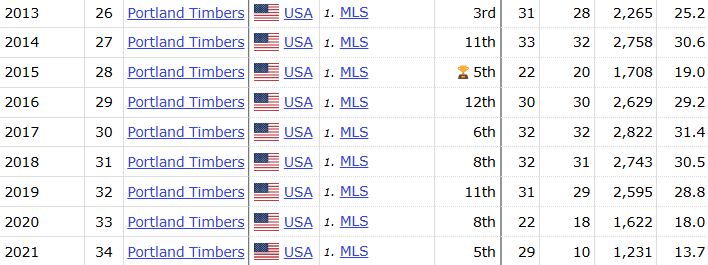
All of you know who this player is. Prior to 2020, Diego Valeri never made more than 3 substitute appearances during a single season. (Quick tangent: Valeri and Chara are the same age. Mind-boggling stuff.) However, with his contract expiring in 2021, El Maestro became a supersub. 29 appearances, 10 starts, and just over 13.5 full games played. Do I expect Chara’s usage to plummet like Valeri’s did? Of course not. But there is a scenario where the Timbers decide to platoon Chara for road games or short weeks. Ortiz and Chara could also complement each other in the double pivot, with Ortiz’s energy allowing the captain to act as a shield. Bottomline: the Timbers have adequate depth in the midfield (they could really add another player just to be safe, like former Oregon State Beaver Hassani Dotson who, coincidentally, just put in a trade request) and are in a position where their 38-year-old captain doesn’t need to be run into the ground.
But this mailbag question wasn’t aimed at whether the Timbers could platoon their greatest ever player. It’s about whether the player himself would be willing to take a minutes reduction. “This year is going to be challenging for me,” Chara said during preseason media availability last week. He also kept talking about how much competition there is for minutes and how it’s the coach’s decision at the end of the day. But he also spoke about his legacy in Portland: “A leader. A guy who never gives up and always tries to do the best for the team.”
Obligatory “build the statue” comment. This answer from Chara says it all. No matter how many minutes he plays, he will do whatever it takes to do the best for the team. He’s made peace with a limited role but will always be pushing for as many minutes as possible. That’s the ultimate expression of leadership. The team always comes first.
Big article coming within the next two weeks. It will only be available to paid subscribers. More preseason content is on the way, including another installment of the “The Case For” series. The season opener is four weeks away. Onwards.
Cascadia FC's Substack is a reader-supported publication. To receive new posts and support my work, consider becoming a free or paid subscriber.

